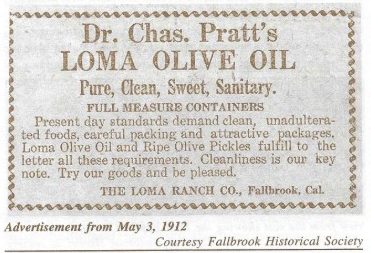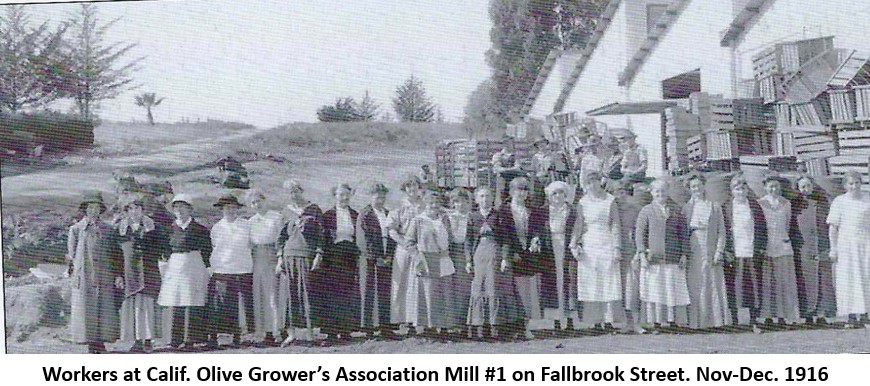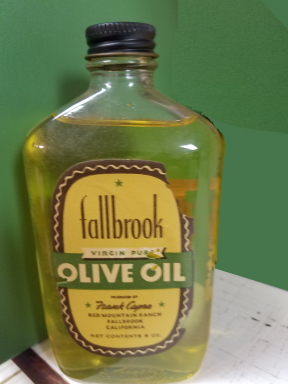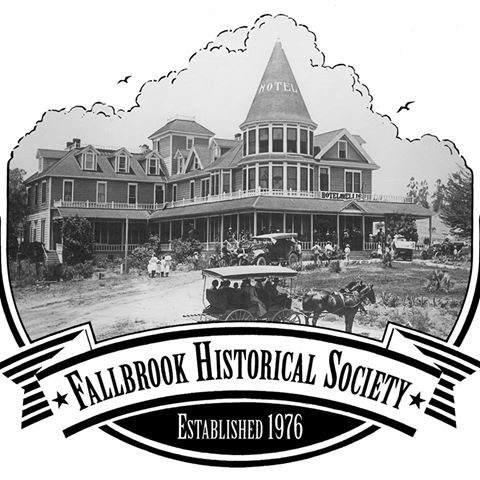An earlier version of this article written by Don Rivers, Fallbrook Historical Society, was published in the Fallbrook Village News Oct. 1, 1998
edited by Tom Frew, Fallbrook Historical Society, 2020
editor’s note: new photos, some details, and historical notes are added.
Fallbrook was once known for its olive industry. Remnants of old olive orchards are scattered all around the Fallbrook area. A large orchard of several hundred acres of olive trees was once in the area bordered by Stage Coach Ln, McDonald Rd, Pepper Tree Ln and Fallbrook St.
Early Fallbrook farmer’s fields were located on dry rolling hills with a very limited supply of water. When farmers began settling here in the late 1800s, irrigation was limited to small areas along the creek bottoms. Therefore, the first commercial crops of the area were grain, hay, and trees; crops that would grow during the winter months when there was sufficient rain, and would withstand the dry hot months of summer.
The olive tree, the oldest known cultivated tree in the world (1), is believed to have originated in Syria or southern Turkey, has been grown in the dry eastern Mediterranean region since about 3000 B.C. The Phoenicians, tribes from modern day Syria or Lebanon, introduced the olive tree to Spain about 1000 B.C. (2).

The olive in Spanish California was first cultivated at Mission San Diego de Alcalá, established in 1769 (3). Just when the first olives were planted in Fallbrook is not confirmed, but Dr. Charles Pratt is acknowledged as the pioneer olive pickler and oil producer in the Fallbrook area. Pratt purchased John North’s 1879 homestead for $6,000 and established Loma Ranch on South Alturas Street in 1895.

The Loma ranch had a large olive orchard with its own olive oil press and bottling plant. It was producing approximately 15,000 gallons of high-grade olive oil annually until 1919. Loma oil was shipped as far as New York. Pratt’s factory was said to be one of the best equipped for its size in California. In 1917 the payroll at the Pratt Fallbrook factory amounted to $1,500 or $2,000 per month (4)

During the period of 1913-1915 olives were the largest cash crop in the Fallbrook area. In 1915 plans were made for an “Olive Day” Celebration to draw attention to Fallbrook and its olive crop. However, concerns about Fallbrook’s ability to draw a large enough crowd to cover festival costs caused the celebration to be postponed indefinitely.
In 1916 the California Olive Growers Association selected Fallbrook to build their Mill #1 The construction of the mill meant that local growers of olives in the Fallbrook district stood to share $50,000 to $70,000 a year for their olive crops. (5)

Today in 2020, this historic building still stands. Fallbrook Fertilizer, Feed and Farm Supply is located in this building at 215 W. Fallbrook Street.
After World War I ended, the domestic market for olive products was greatly diminished as imports from Spain, Italy, and Greece resumed. The Loma Ranch changed over to producing citrus and eventually became a leading dairy in Fallbrook. The Olive Growers Association mill on Fallbrook St. became a cannery for lemons and tomatoes. Many years later the same building was destined to become important again as an avocado packing plant. But that’s another story.

Red Mountain Ranch, to the northeast of Fallbrook along Mission road at the top end of Live Oak Canyon, was another of the early major olive oil producers. Red Mountain had its own processing plant, which existed into the late 1970s. James V. Hicks originally homesteaded this ranch in 1881 (6),
The original cattle pastures around Red Mountain have been planted to olives. Red Mountain Ranch changed ownership several times, and each owner introduced new varieties of trees and crops, including citrus and avocado groves, which were supplied with water from a series of wells and reservoirs on the ranch before the establishment of water districts.
George Hauck, one of these Red Mountain Ranch owners was also president of a large auto parts manufacturing firm in Detroit, Michigan. He desired a direct communication link with the outside world, which was not available in Fallbrook at that time, so he established a private telephone line from the ranch to Escondido. Hauck was a leading champion of the Fallbrook business community, until he died suddenly in 1919.
The next Red Mountain owner, J. Grant Kingburg, added a large reservoir and extended the plantings. His telephone number attests to the size of Fallbrook and its telephone system in 1923 – his number was 5-F-2.

After WWI when olive farming had become less profitable, the hardy olive trees on Red Mountain had to survive years of neglect and continue growing with whatever rain fell on them. Movie director Frank Capra, whose family came from Sicily, bought Red Mountain Ranch in 1939, sight unseen, for $70,000 (7) from the Masselli brothers. During WWII, Italian and Greek exports of olive oil were stopped again. After rehabilitating the 105 acres of neglected olive trees that had not been tended in over 10 years, and putting the olive press back into production, Capra started an olive oil mail order business labeled Fallbrook Olive Oil “Produced by Frank Capra”. Bottles of Red Mountain’s olive oil can be found in the Fallbrook Historical Society Museum.
Capra himself served as an American Army officer in WWII.
After World War II, European imports
flooded the market again and eventually ruined the Fallbrook olive business
once more.

Capra continued to split his time between Los Angeles and his Fallbrook ranch in the 1940s and 1950s. Capra’s civic involvement led him to join other Fallbrook ranchers in challenging the U.S. Government over water rights to the Santa Margarita River. He produced the movie ‘The Fallbrook Story’ to publicize the issue.

Another producer in the 1930s was Joe Barbuscia and his Palomar Olive Products. Joe was a hardworking man of sturdy frame. He was born in Italy and came to this country when he was 20 years old. Barbuscia formed a partnership with Fallbrook school superintendent James Potter, operating an olive oil processing plant in the old olive grove on Alturas Street between today’s Aviation Rd and Beech St. He also owned a 300-acre orchard on Olive Hill Road. Their mill was still standing as late as 1980. A rare Palomar olive oil bottle is on display at The Fallbrook Historical Society.

Joe Smarr who bought the old Ellis hotel in Fallbrook in 1925 also owned a 160-acre ranch in De Luz. He had a house and barn on the lower end of the valley where Daily Lake is today. On the ranch was an olive orchard that was located on the north side of the creek across from the house. In the large wooden barn was a round concrete circular table pressing from which an axle protruded upward. From this vertical axle ran a long axle on which turned a concrete roller that was pulled around the concrete table by a horse. The olives were smashed and the juice was collected and filtered. The juice was placed in settling tanks, where the oil separated from the juice. The oil was then washed with warm water then filtered again. A period of a couple months was allowed for hydrolysis of the bitter principle, then the oil was processed and bottled for shipping.
How Fallbrook Olive Oil was pressed
Pickled
olives were brought in and placed in a disintegrator, a machine with steel
screens and hammers run by an electric motor.
The olives, including the seeds, were ground to a pulp or slurry.
The slurry was then ground by two giant granite wheels that were 18 inches
wide. This ensured that no sharp seed
particles were left.
The slurry was placed in pads of hemp sacking. These pads were called cheese cakes, about four feet square.
The cheese cakes were put in a primary press with a pressure of 20 tons per square foot. The resulting oil is the best. After the primary press, the cheese cakes were put in a secondary press of 150 tons per square foot. The oil was warmed and put in a separator to eliminate tannic acid. This is a critical point in production as the oil contains a waxy substance called steron,
The oil was put into storage tanks, drained into cans and shipped out as Fallbrook Olive Oil produced by Frank Capra. (8)
